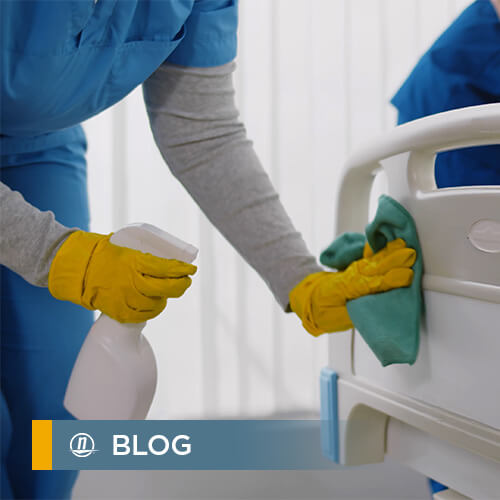Disinfecting Your Facility: A Guide to Disinfectants
Disinfectants are essential for maintaining cleanliness and preventing the spread of germs and bacteria in healthcare facilities, schools, and offices. For example, disinfectants play a critical role in reducing healthcare associated infections (HAIs), where studies show 1 in 31 hospitalized patients are adversely impacted.1 When picking a disinfectant for your facility, it’s important to consider:
- Types of surfaces you need to clean.
- Types of germs such as: bacteria, viruses, and fungi that need to be killed.
- Potential hazards associated with each type of disinfectant, including type of PPE, and storing requirements.
- Environmental impact of the disinfectant.
- Availability of the product.
With a wide range of available options, choosing the right disinfectant for your facility can be overwhelming. Here are some of the most common types of disinfectants and their benefits to help you make the best choice when cleaning your facility.
- Hydrogen Peroxide: Hydrogen peroxide is a highly effective disinfectant that can kill a wide range of bacteria, viruses, and fungi. It is safe to use on a variety of surfaces and is environmentally friendly, since it breaks down into water and oxygen after use. However, hydrogen peroxide has a short shelf life and needs to be stored in a cool, dark place.
- Quaternary Ammonium Compounds (Quats): Quats are a popular choice for disinfecting hard surfaces in facilities. They are highly effective against bacteria and viruses and are available in various forms including sprays, wipes, and solutions. Quats can cause dermal irritation that may lead to skin sensitization, and an increased risk of asthma, so it’s important to follow the manufacturer’s instructions carefully. Quats can also build up on surfaces over time, reducing their efficacy.
- Hypochlorite: Hypochlorite is commonly used as an active ingredient in bleach and can be used as a disinfectant. It is effective against a wide range of bacteria and viruses but can be harsh on surfaces and fabrics. It can also be toxic if not used properly, which is why it should not be mixed with other cleaning products and should be used in a well-ventilated area.
- Phenolics: Phenolics are a type of disinfectant that is highly effective against bacteria, viruses, and fungi. They are often used in healthcare facilities and are available in various forms including sprays, wipes, and solutions. Phenolics have a strong odor and can cause skin irritation, so it’s important to use them with caution and the correct personal protective equipment.
- Alcohol: Alcohol-based disinfectants, such as ethanol and isopropyl alcohol, are commonly used to clean and disinfect surfaces. They’re effective against bacteria and viruses and are safe to use on a variety of surfaces. However, they can be flammable and may evaporate quickly, reducing their efficacy.
- Peracetic Acid: Peracetic acid is a very effective disinfectant that is used in various industries, including healthcare, food processing, and food & beverage. It’s highly effective against bacteria, viruses, and spores, and is safe to use on a variety of surfaces. However, peracetic acid can be harsh on skin and surfaces, and may cause respiratory irritation if not used properly.
Selecting the right disinfectant for your facility is crucial for maintaining the cleanliness and preventing the spread of germs. With the wide range of options available, working with a specialty distributor, like Network, can help you choose the right disinfectant that is safe, effective, and suitable for your facility’s needs. By considering the types of disinfectants available and their benefits, you can make an informed decision that meets your needs and keeps your facility safe and healthy.
Sources:
- “FAQs about HAI Progress Report” by CDC https://www.cdc.gov/hai/data/portal/FAQs-progress-report.html
- National Education Association https://www.nea.org
- “Disinfection and Sterilization” by CDC https://www.cdc.gov/infectioncontrol/guidelines/disinfection/index.html




